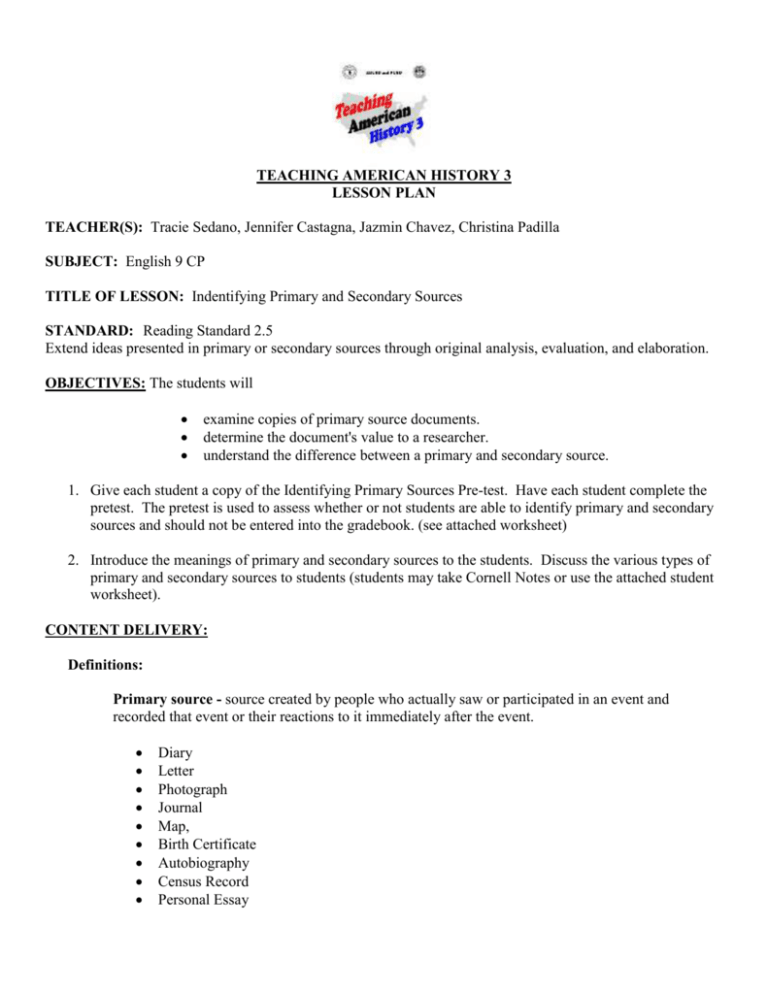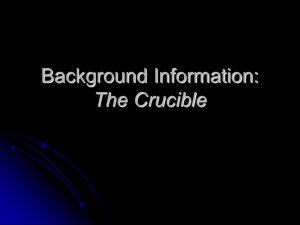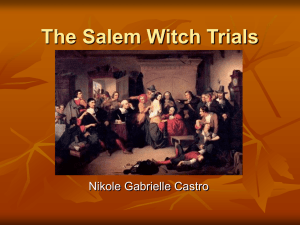Primary Soruce Lesson
advertisement

TEACHING AMERICAN HISTORY 3 LESSON PLAN TEACHER(S): Tracie Sedano, Jennifer Castagna, Jazmin Chavez, Christina Padilla SUBJECT: English 9 CP TITLE OF LESSON: Indentifying Primary and Secondary Sources STANDARD: Reading Standard 2.5 Extend ideas presented in primary or secondary sources through original analysis, evaluation, and elaboration. OBJECTIVES: The students will examine copies of primary source documents. determine the document's value to a researcher. understand the difference between a primary and secondary source. 1. Give each student a copy of the Identifying Primary Sources Pre-test. Have each student complete the pretest. The pretest is used to assess whether or not students are able to identify primary and secondary sources and should not be entered into the gradebook. (see attached worksheet) 2. Introduce the meanings of primary and secondary sources to the students. Discuss the various types of primary and secondary sources to students (students may take Cornell Notes or use the attached student worksheet). CONTENT DELIVERY: Definitions: Primary source - source created by people who actually saw or participated in an event and recorded that event or their reactions to it immediately after the event. Diary Letter Photograph Journal Map, Birth Certificate Autobiography Census Record Personal Essay Secondary source - source created by someone either not present when the event took place or removed by time from the event. Encyclopedias Biographies Newspaper/Magazine Articles Cliff Notes Social Studies Book Documentary As a class, discuss the following questions regarding primary and secondary sources. What do the primary and secondary sources in each list have in common? What is the difference between primary and secondary sources? What types of information do primary sources provide? What are the benefits of both primary and secondary resources? What are the challenges of using both primary and secondary resources? Which type of resource do you use most often? Why? What other resources should be added to the list? As a class, discuss the following questions regarding primary and secondary sources. 1. What do the primary and secondary sources in each list have in common? ___________________________________________________________________________ 2. What is the difference between primary and secondary sources? ___________________________________________________________________________ 3. What types of information do primary sources provide? ___________________________________________________________________________ 4. What are the benefits of both primary and secondary resources? ___________________________________________________________________________ 5. What are the challenges of using both primary and secondary resources? ___________________________________________________________________________ 6. Which type of resource do you use most often? Why? ___________________________________________________________________________ 7. What other resources should be added to the list? ___________________________________________________________________________ MATERIALS NEEDED: Primary source documents – Map of Salem Village, Arrest Warrant, Examination of Tituba, List of the Dead and Death Warrant ACTIVITY: Directions: 1. Have students examine the documents and answer the following questions: What type of document is it? What is the date of the document? Who created the document? Why was the document created? Any distinguishing marks or features on the document (date stamps, someone else's notes in the margin,...)? 2. Consider the following questions: What does the existence of this document say about whoever created it? What does this document say about American life in this era? Ask students if they believe the document is an accurate representation of what was happening. Why do they believe that? Do students think that outside events could influence what a person might write or record about an event? Do students think that outside events could influence the way that they are interpreting the document? What questions are left unanswered by the document? If you could ask the author of the document a question, what would you ask? Have students exchange documents and answer the questions about their new document. ASSESSMENT: Give each student a copy of the Identifying Primary Sources Post-test. Have each student complete the posttest. The posttest may be entered into the gradebook. (see attached worksheet) FOLLOW-UP ACTIVITIES: 1. Suggest to students that they have primary source documents at home (driver's license, birth certificate, report card, yearbook, letter, diary,...). 2. Ask students to bring in a document that they would be willing share with the class and analyze the documents. Name _____________________________________ Date ______________________ Period ________ Primary and Secondary Sources Notes Primary source - ________________________________________________________________________ _______________________________________________________________________________________ _____________________________________ _____________________________________ _____________________________________ _____________________________________ _____________________________________ _____________________________________ _____________________________________ _____________________________________ Secondary source - ______________________________________________________________________ _______________________________________________________________________________________ _____________________________________ _____________________________________ _____________________________________ _____________________________________ _____________________________________ _____________________________________ Name __________________________________________ Date ____________________ Period _______ Identifying Primary Sources Pretest Read the following examples of sources. Place a P by the items that are PRIMARY SOURCES and an S by the items that are SECONDARY SOURCES. _____1. A comprehensive collection from Douglas O. Linder, it includes books, petitions, and other documents produced at the time. _____2. A free ebook about the Salem witch trials in PDF that you can read on your Ipad, Kindle, or anything else. _____3. The Salem Witchcraft Papers - includes transcripts of judicial hearings, petitions, indictments, execution warrants, and other legal documents. _____4. Diary kept by Elizabeth Proctor _____5. A diary containing the Reverend Cotton Mather's account of the Salem witch trials. _____6. Letter written by Emily Smith to her friend Pamela Jones _____7. The Salem Witch Trials: A Reference Guide _____8. The Salem Witchcraft Trials: A Legal History _____9. Salem Story: Reading the Witch Trials of 1692 _____10. A book by Robert Calef, who, at the time of the Salem witch trials, mocked Mather's account and the general idea of witchcraft. _____11. Tituba, Reluctant Witch of Salem: Devilish Indians and Puritan Fantasies _____12. Map of Salem Village drawn in 1692 _____13. Information about the Salem witch trials in World Book Encyclopedia _____14. Cassette tape of an interview with Dr. James Lee describing the lives of the people in Salem during the time of the trials _____15. The Story of Salem, a textbook by Virginia Van der Veer Hamilton Name _____________________________________________ Date ________________ Period __________ Identifying Primary Sources Posttest Read the following examples of sources. Place a P by the items that are PRIMARY SOURCES and an S by the items that are SECONDARY SOURCES. _____1. A comprehensive collection from Douglas O. Linder, it includes books, petitions, and other documents produced at the time. _____2. A free ebook about the Salem witch trials in PDF that you can read on your Ipad, Kindle, or anything else. _____3. The Salem Witchcraft Papers - Includes transcripts of judicial hearings, petitions, indictments, execution warrants, and other legal documents. _____4. Diary kept by Elizabeth Proctor _____5. A diary containing the Reverend Cotton Mather's account of the Salem witch trials. _____6. Letter written by Emily Smith to her friend Pamela Jones _____7. The Salem Witch Trials: A Reference Guide _____8. The Salem Witchcraft Trials: A Legal History _____9. Salem Story: Reading the Witch Trials of 1692 _____10. A book by Robert Calef, who, at the time of the Salem witch trials, mocked Mather's account and the general idea of witchcraft. _____11. Tituba, Reluctant Witch of Salem: Devilish Indians and Puritan Fantasies _____12. Map of Salem Village drawn in 1692 _____13. Information about the Salem witch trials in World Book Encyclopedia _____14. Cassette tape of an interview with Dr. James Lee describing the lives of the people in Salem during the time of the trials _____15. The Story of Salem, a textbook by Virginia Van der Veer Hamilton






